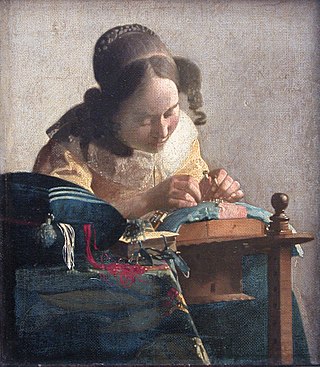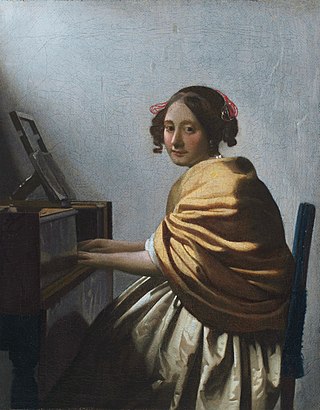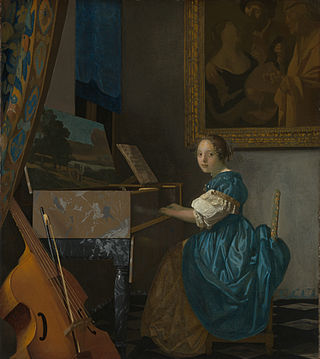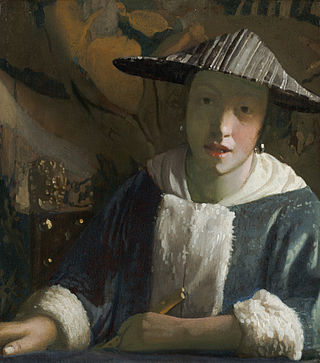
Johannes Vermeer was a Dutch Baroque Period painter who specialized in domestic interior scenes of middle-class life. He is considered one of the greatest painters of the Dutch Golden Age. During his lifetime, he was a moderately successful provincial genre painter, recognized in Delft and The Hague. He produced relatively few paintings, primarily earning his living as an art dealer. He was not wealthy; at his death, his wife was left in debt.

The Little Street is a painting by the Dutch painter Johannes Vermeer, executed c. 1657-1658. It is exhibited at the Rijksmuseum of Amsterdam, and signed, below the window in the lower left-hand corner, "I V MEER".

The Music Lesson, Woman Seated at a Virginal or A Lady at the Virginals with a Gentleman by Johannes Vermeer is a painting of a young female pupil receiving a music lesson from a man. The man's mouth is slightly agape giving the impression that he is singing along with the music that the young girl is playing. This suggests that there is a relationship between the two figures and the idea of love and music being bridged together. This was a common theme among Netherlandish art in this time period. Vermeer consistently used the same objects within his paintings such as the draped rug, the white water jug, various instruments, tiled floor and windows that convey light and shadows. This is one of few paintings produced by Vermeer which were kept in his home until his death in 1675 when his family was forced to sell them. It became a part of the Royal Collection, and it is currently on display in the Queen's Gallery at Buckingham Palace in London.

Pieter Claeszoon van Ruijven has been known as Johannes Vermeer's main patron for the better part of the artist's career, but in 2023 his wife Maria de Knuijt was identified by the curators of the 2023 exhibition of Vermeer's works at the Rijksmuseum, in Amsterdam as the main patron due to her long-standing and supportive relationship with the artist. He built a sizeable estate from inheritances he and his wife received and fruitful investments. In 1669, he became the Lord of Spalant when he purchased land owned by Willem, Baron van Renesse.

Christ in the House of Martha and Mary is a painting finished in 1655 by the Dutch Golden Age painter Johannes Vermeer. It is now in the Scottish National Gallery in Edinburgh. It is the largest painting by Vermeer and one of the very few with an overt religious motive. The story of Christ visiting the household of the two sisters Mary of Bethany and Martha goes back to the New Testament. The work has also been called Christ in the House of Mary and Martha.

The Lacemaker is a painting by the Dutch artist Johannes Vermeer (1632–1675), completed around 1669–1670 and held in the Louvre, Paris. The work shows a young woman wearing a yellow bodice, holding up a pair of bobbins in her left hand as she carefully places a pin in the pillow on which she is making her bobbin lace.

A Young Woman Seated at the Virginals is a painting today attributed to Johannes Vermeer, though this was for a long time widely questioned. A series of technical examinations from 1993 onwards confirm the attribution. It is thought to date from c.1670 and is now in part of the Leiden Collection in New York. It should not be confused with Young Woman Seated at a Virginal in the National Gallery, London, also by Vermeer.

Lady Seated at a Virginal, also known as Young Woman Seated at a Virginal, is a genre painting created by the Dutch Golden Age painter Johannes Vermeer in about 1670–1672 and now in the National Gallery, London.

Officer and Laughing Girl, also known as Officer and a Laughing Girl, Officer With a Laughing Girl or, in Dutch, De Soldaat en het Lachende Meisje, was painted by the Dutch artist Johannes Vermeer in around 1657. It was painted in oil on canvas, typical of most Dutch artists of the time, and is 50.5 by 46 cm. It is now one of three pictures by Vermeer in The Frick Collection in New York

Girl with a Red Hat is a rather small painting, signed by the Dutch painter Johannes Vermeer. It is seen as one of a number of Vermeer's tronies – depictions of models fancifully dressed that were not intended to be portraits of specific, identifiable subjects. Whether Vermeer chose family members as models or found them elsewhere in Delft is irrelevant to the appreciation of his paintings. Its attribution to Vermeer – as it is on a (recycled) wood panel and not on canvas – has been a matter of controversy with scholars on both sides of the argument. However, in recent study carried out by the curators of National Gallery of Art certainty has been established on the authorship of the painting by Vermeer, a conclusion also supported by Dutch experts.

View of Delft is an oil painting by Johannes Vermeer, painted c. 1659–1661. The painting of the Dutch artist's hometown is among his best known. It is one of three known paintings of Delft by Vermeer, along with The Little Street and the lost painting House Standing in Delft, and his only cityscape. According to art historian Emma Barker, cityscapes across water, which were popular in the Netherlands at the time, celebrated the city and its trade. Vermeer's View of Delft has been held in the Dutch Royal Cabinet of Paintings at the Mauritshuis in The Hague since its establishment in 1822.

Girl Reading a Letter at an Open Window, also known as Lady reading at an open window, is an oil painting by Dutch Golden Age painter Johannes Vermeer. Completed in approximately 1657–1659, the painting is on display at the Gemäldegalerie in Dresden, which has held it since 1742. For many years, the attribution of the painting—which features a young Dutch woman reading a letter before an open window—was lost, with first Rembrandt and then Pieter de Hooch being credited for the work before it was properly identified in 1880. After World War II, the painting was briefly in possession of the Soviet Union. In 2017, tests revealed that the painting had been altered after the painter's death.

The Procuress is a 1656 oil-on-canvas painting by the then 24-year-old Johannes Vermeer. It can be seen in the Gemäldegalerie Alte Meister in Dresden. It is his first genre painting and shows a scene of contemporary life, an image of mercenary love perhaps in a brothel. It differs from his earlier biblical and mythological scenes. It is one of only three paintings Vermeer signed and dated. In 1696 the painting, being sold on an auction in Amsterdam, was named "A merry company in a room".
Jacob Abrahamsz. Dissius was a Dutch typographer and printer. He inherited a collection of 21 of Johannes Vermeer's works, including The Milkmaid, Portrait of a Young Woman, A Girl Asleep, Woman Holding a Balance, and The Music Lesson. In 1680, he married Magdalena, daughter and sole heir of Vermeer's main patron Maria de Knuijt, her mother, with her father Pieter van Ruijven. Dissius died in 1695, and his collection was auctioned off in Amsterdam the following year.

The Girl with the Wine Glass is an oil on canvas painting by Johannes Vermeer, created c. 1659–1660, now in the Herzog Anton Ulrich Museum, in Braunschweig.

Woman with a Pearl Necklace by Johannes Vermeer is a Dutch Golden Age painting of about 1664. Painted in oils on canvas, Johannes Vermeer portrayed a young Dutch woman, most likely of upper-class descent, dressing herself with two yellow ribbons, pearl earrings, and a pearl necklace. As a very popular artist of the 17th century, the Dutch Golden Age, Vermeer depicted many women in similar circumstances within interior, domestic scenes. The same woman also appears in The Love Letter and A Lady Writing a Letter.

Mistress and Maid is an oil-on-canvas painting produced by Johannes Vermeer c. 1667. It portrays two women, a mistress and her maid, as they look over the mistress' letter. The painting displays Vermeer's preference for yellow and blue, female models, and domestic scenes. It is now in the Frick Collection in New York City.

Girl with a Flute is a small painting attributed to either Johannes Vermeer or one of his associates. It is currently believed to have probably been painted between 1669–1675. It is owned by the National Gallery of Art in Washington, D.C. along with three paintings attributed to Vermeer: Woman Holding a Balance, A Lady Writing a Letter, and Girl with a Red Hat.

Johannes Vermeer was a Dutch Baroque Period painter who specialized in domestic interior scenes of middle class life. His works have been a common theme in literature and films in popular culture since the rediscovery of his works by 20th century art scholars.
Maria Simonsdr de Knuijt was a patron of the Dutch painter Johannes Vermeer. She provided support and financial assistance to Vermeer throughout his career. De Knuijt was married to Pieter van Ruijven, a wealthy citizen of Delft, Netherlands. Pieter had been identified as Vermeer's main patron, owning more than half of Vermeer's oeuvre. Scholarship in 2023 identified de Knuijt as the main patron, as she had known him for some time and was more directly involved with the artist. After van Ruijven and de Knuijt died, their estate was inherited by their daughter Magdalena. She died about one year after her mother, and the estate was then inherited by her husband Jacob Dissius and his father Abraham Dissius.
















